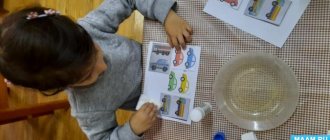Integration of educational areas: “Socio-communicative development”, “Speech development”, “Musical development”. Objectives: 1. Strengthen the ability to distinguish and name the seasons (“Cognitive development”). 2. Continue to teach how to solve riddles, understand the poetic comparisons underlying the riddle (“Speech Development”). 3. Continue to teach how to see the shape of objects, correlate it with the names of geometric shapes: square, triangle, square (“Cognitive development”). 4. Continue to teach how to compare objects by size and reflect the result of the comparison in speech. (“Cognitive Development”). 5. Continue to teach how to navigate in two-dimensional space. (“Cognitive Development”). 6. Foster independence, purposefulness and self-regulation of one’s own actions. (“Social and communicative development”). 7. Develop emotional responsiveness (“Social and communicative development”). 8. Form a sense of rhythm and coordination of movements. (“Musical Development”).
Methods and techniques: Visual: looking at the panel “Smeshariki in the Forest”. Verbal: teacher’s story, questions for children; reciting the text of the physical education lesson; pronouncing the words of the counting rhyme and outdoor game for the teacher. Practical: physical education, outdoor game.
Materials and equipment: panel with removable elements “Smeshariki in the forest”
GCD move:
Educator: Hello, guys! Today I will tell you the fairy tale “About Mashenka and Smeshariki.” Once upon a time there was Mashenka. She went into the forest for a walk. And in the forest the grass is green, the sun is shining brightly, the flowers are blooming. Who knows when this happens? Children: in the summer! (answer in unison) V.: Correct. Guess the riddle. 1. The sun is baking, the linden tree is blooming, the rye is ripening, when does this happen? D.: In the summer. 2. The snowball is melting, the meadow has come to life, the day remains, when does this happen? D.: In the spring. 3. The fields are empty, the ground is getting wet, the day is waning, when does this happen? Guys, what time of year is the riddle about? Guys, do you know what colors can be used to represent each season? For example, Winter is white. What color is autumn? D.: Yellow. V.: What about summer? D.: Green. V.: That's right, well done. As she walked and walked, Mashenka saw a tall Christmas tree and decided to run around it. Suddenly I noticed mushrooms, large and small, growing under a low tree. — Under what tree did the mushrooms grow? D.: Mushrooms grew under the low Christmas tree. V.: Show me the big mushroom. - And also, what kind of Christmas tree grew in the clearing? D.: A tall Christmas tree grew in a clearing. V.: Mashenka picked a big mushroom, then a small one and went home. She walked and walked and saw a house in a clearing, and Smeshariki were walking around the house. Mashenka greeted them and got to know them. Their names are: Nyusha, Barash, Krosh and Hedgehog. Mashenka asked them: -What geometric shapes did you use to build your house? But Smeshariki do not know geometric shapes. - Guys, help the Smeshariki. D.: From a square, a triangle. V.: That's right. The roof, what geometric figure does it look like? D.: Square. Q: What about the walls of the house? — What color is the triangle? D.: Blue. Q: What blue figure do you still see? Come and show me the picture. D.: Square. V.: Show me the square. How many squares do you see? D.: Two squares. Q: What figure do Smeshariki themselves resemble? D.: In circles. V.: Show me the circles. - Count how many smeshariki there are? D: Four. Q: How many Christmas trees? D.: Two. Q: Which figures are there more? D.: Krugov, Smeshariki. Q: What kind of Christmas trees do you see? D: High and low. V.: Find a tall Christmas tree in the picture. Is the grass tall or short? D.: Low. V.: Tell me and show which of the Smeshariki has long hair. D.: At Nyusha’s. Q: What kind of hair does Barash have? D.: Short. V.: Look at the sun. What are the rays of the sun? D. Short and long. V.: Guys, let's look at the picture and name the objects one by one. D.: House, Sun. Q: What color is the sun? D.: Red. V.: Show the long rays of the sun. — If the sun is shining brightly, what time of day is it? When does this happen? D.: During the day.
Physical education minute.
We are getting higher and higher, We reach the roofs with our hands, One-two we went up, One-two our hands down. (repeat)
Smeshariki liked the way you did the exercises so much, and they want to play Hide and Seek. To start the game you need to count. Teacher and children in chorus: One, two, three, four, five. The bunny went out for a walk. What should we do, what should we do? We need to catch the bunny. Again we will count: One, two, three, four, five. Now that everyone has been counted, the Smeshariki are hiding. V.: Guys, let’s look for Mashenka and who is hiding where? (The teacher shows the animals, the children answer) D.: Nyusha hid in the house. -Krosh jumped onto a stump. -Barash hid behind the house. — The hedgehog buried himself up to a stump. (then swap places of Smeshariki, repeat the game). V.: Mashenka and we found all the Smeshariki. - How many Smeshariki are there in total? D: Four. Q: Where does the sun shine from? Where is it located? D: From above. The sun is over the house, over the Christmas trees. Q: Did you like working with Smeshariki? Let's take the little one and play a fun game with him.
Outdoor game “The gray bunny is sitting.”
The little gray bunny sits and wiggles his ears, Like this, this way he wiggles his ears, It’s cold for the bunny to sit, I need to warm up my paws, Clap, clap, clap, clap, I need to warm up my little paws, It’s cold for the bunny to stand, The bunny needs to jump, Jump, jump, jump, the bunny needs to gallop. Someone scared the bunny, so the bunny galloped away. V.: Mashenka really liked Smeshariki. Did you like it? Shall we invite them to class again? D.: Yes, come see us again! V.: And now it’s time for Mashenka to go home. Guys. Let's say goodbye. D.: Goodbye, Mashenka and Smeshariki!






